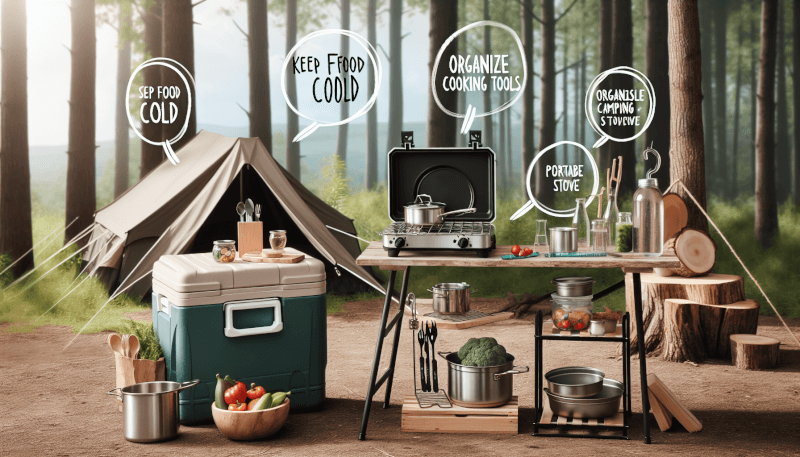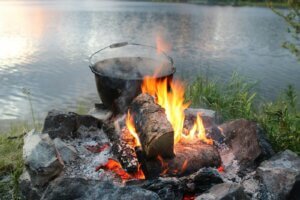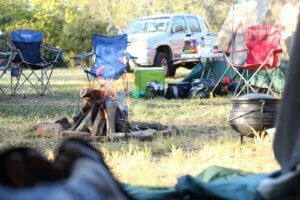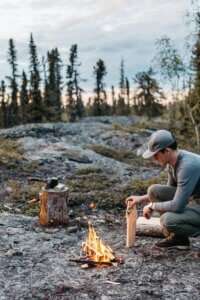So, you’ve finally decided to embark on your first camping adventure. Congratulations! Now, before you head out into the great outdoors, it’s essential to know how to set up a camp kitchen properly. But don’t worry, this article is here to guide you through every step of the process. From choosing the right camping stove to organizing your cooking utensils, we’ll cover it all. By the end, you’ll be well-equipped to enjoy delicious meals under the stars and become a pro at setting up your very own camp kitchen.
Choosing a Suitable Campsite
When planning a camping trip, one of the first decisions you’ll need to make is choosing a suitable campsite. Researching campgrounds is a crucial step in this process as it allows you to gather information about the available options. Look for campgrounds that have good reviews, convenient facilities, and suitable amenities that match your needs and preferences.
Considering the location is another important factor to take into account when choosing a campsite. Decide whether you prefer a remote or a more accessible location. Consider the proximity to water sources, hiking trails, and other activities you may be interested in. Additionally, think about the terrain conditions of the campsite. Look for a flat and level ground that is suitable for pitching your tent and setting up your camp kitchen comfortably.
Checking campsite amenities is essential to ensure a comfortable camping experience. Look for amenities such as picnic tables, firepits, and access to clean water. Some campgrounds may even offer electricity, showers, and laundry facilities. Consider which amenities are important to you and make sure they are available at the campsite you choose.
Assessing terrain conditions is crucial for safety and convenience. Look for potential hazards such as stumps, rocks, or uneven ground that may pose a risk. Ensure that the campsite has suitable conditions for pitching your tent and setting up your camp kitchen. By carefully considering these factors, you can choose a campsite that suits your needs and ensures an enjoyable camping experience.
Essential Kitchen Equipment
Having the right kitchen equipment is crucial for cooking delicious meals during your camping trip. Here are some essential items you should include in your camp kitchen:
Cooking stove and fuel
Investing in a reliable cooking stove is essential. Choose a stove that is lightweight, easy to use, and suitable for outdoor cooking. Consider the type of fuel the stove uses and ensure you have an adequate supply for your camping trip.
Cooking utensils
Pack a set of cooking utensils including a spatula, tongs, a ladle, and a whisk. These tools will come in handy when preparing and serving meals at the campsite.
Cutlery and dishes
Bring along reusable cutlery, plates, bowls, and cups. Opt for lightweight and durable materials such as stainless steel or BPA-free plastic. Remember to pack enough for everyone in your camping group.
Food storage containers
Invest in airtight and waterproof food storage containers to keep your food fresh and protected from animals. Separate containers for different food items will help keep your ingredients organized and make meal preparation more efficient.
Water containers
Bringing along water containers is essential for staying hydrated during your camping trip. Opt for BPA-free water bottles or collapsible water containers that are easy to transport and store.
Cooler or refrigerator
If you plan on bringing perishable food items, a cooler or portable refrigerator is a must. This will help keep your food at a safe temperature and prevent spoilage. Look for a cooler with insulation and consider bringing ice packs or frozen water bottles to keep the contents cool.
Planning Meals and Food
Creating a meal plan is essential to ensure you have enough food for the duration of your camping trip. Consider the number of meals you’ll need to prepare and make a list of ingredients for each meal. Take into account the dietary preferences and restrictions of everyone in your camping group.
Choosing easy and nutritious recipes will help simplify your camp cooking experience. Look for recipes that require minimal preparation and use ingredients that are easy to store and transport. One-pot meals, such as stews or stir-fries, can be a great option as they simplify the cooking process and minimize cleanup.
To make meal preparation easier, consider preparing ingredients in advance. Chop vegetables, marinate meat, and pre-cook certain components of your meals at home before heading to the campsite. This will save you time and make cooking at the campsite more efficient.
When planning your meals, consider any dietary restrictions in your camping group. Make sure to have options for vegetarians, vegans, or those with food allergies. It’s also a good idea to bring along some non-perishable snacks for quick and easy munching between meals.
Organizing and packing food properly is essential for a successful camping trip. Pack perishable items in the cooler or refrigerator and make sure they are kept at a safe temperature. Separate them from non-perishable items to prevent cross-contamination. Label your food containers and store them in airtight bags or containers to keep them organized and protected from insects or animals.
Setting Up the Cooking Area
Designating a suitable space for your camp kitchen is essential for efficient and safe cooking. Here are some steps to set up your cooking area:
Finding a suitable space
Look for a level and flat area away from your sleeping area to set up your cooking space. Ensure there are no low-hanging branches or potential hazards nearby.
Clearing potential hazards
Before setting up your cooking area, clear the space of any potential hazards such as loose rocks, branches, or dry foliage. This will help prevent accidents and ensure a safe cooking environment.
Pitching a kitchen shelter
If you expect adverse weather conditions, consider bringing a kitchen shelter such as a canopy or tarp. This will protect you and your cooking area from rain or direct sunlight. Ensure the shelter is securely set up and stable to withstand wind or other weather elements.
Setting up a cooking table
Having a designated table for your cooking area will provide a stable surface for meal preparation. You can use a folding table, a portable countertop, or even a sturdy board placed on top of a tablecloth.
Arranging cooking equipment
Organize your cooking equipment by placing it near the cooking table for easy access. Ensure items such as the stove, pots, and pans are securely placed to prevent accidents or spills. Keep utensils and other tools within reach for convenient meal preparation.
Water and Hygiene
Ensuring a clean and safe water supply is vital for staying hydrated and practicing good hygiene during your camping trip. Here are some considerations for water and hygiene:
Finding a water source
Check the campsite or nearby areas for a reliable water source. It may be a freshwater stream, lake, or a designated water tap at the campground. Ensure the water source is suitable for drinking or follow any guidance provided by the campground.
Treating and filtering water
If the water source is not potable or if you’re unsure of its safety, it’s important to treat and filter the water before using it. Carry a water filter or purification tablets to eliminate any harmful bacteria or contaminants from the water. Follow the instructions provided with your chosen water treatment method.
Setting up a handwashing station
Maintaining proper hygiene while camping is essential. Set up a handwashing station with soap and water near your cooking area. Use biodegradable soap to minimize environmental impact, and always wash your hands before and after handling food.
Managing waste and garbage
Properly managing waste and garbage is not only important for maintaining cleanliness but also for minimizing human impact on the environment. Bring garbage bags and disposable gloves to collect and dispose of waste responsibly. Follow campground guidelines and regulations for proper waste disposal.
Safety Considerations
Ensuring safety during your camping trip is crucial. Here are some safety considerations to keep in mind:
Ensuring fire safety
If you plan on having a campfire, follow local regulations and guidelines for fire safety. Choose a safe location for your campfire away from flammable materials and always have a water source nearby to extinguish the fire properly.
Storing food safely
To prevent attracting wildlife, store your food securely in airtight containers or coolers. Hang food bags from a tree branch using a bear-resistant food storage system, or utilize designated food lockers if provided by the campground. This will help minimize the risk of encounters with animals and keep both you and the wildlife safe.
Keeping a safe distance from wildlife
While camping, it’s important to respect and admire wildlife from a safe distance. Avoid approaching or feeding animals, as this can disrupt their natural behaviors and potentially lead to dangerous situations. Keep all food and scented items properly stored to reduce the likelihood of attracting wildlife to your campsite.
Using proper knife handling techniques
When using knives during meal preparation, always maintain caution and practice proper knife handling techniques. Keep your fingers away from the blade and use a cutting board or stable surface to avoid accidents. Store knives safely in sheaths or blade covers when not in use.
Practicing general camping safety
Lastly, remember to practice general camping safety measures. Carry a first-aid kit, familiarize yourself with emergency procedures, and inform someone of your camping plans. Be aware of your surroundings, dress appropriately for the weather conditions, and always follow campground rules and regulations.

Cooking Techniques for Camp
Knowing various cooking techniques for camp will enhance your camping culinary experience. Here are some techniques to master:
Mastering campfire cooking
Cooking over a campfire can bring a unique flavor to your meals. Learn how to build and maintain a campfire, and utilize techniques such as grilling, skewering, and using cast iron cookware. Experiment with different temperatures and cooking methods to achieve the desired results.
Using a camping stove effectively
A camping stove is a versatile and efficient tool for cooking in the outdoors. Familiarize yourself with your stove’s settings and learn how to adjust the flame for optimal cooking control. Practice using different cooking techniques such as simmering, boiling, and sautéing on your stove.
Making the most of one-pot meals
One-pot meals are convenient and minimize cleanup. Explore recipes that allow you to cook an entire meal in a single pot or skillet. This technique is ideal for dishes such as stews, soups, pasta, or stir-fries.
Utilizing foil packets and skewers
Foil packets and skewers are great for cooking individual portions or grilling smaller items. Wrap seasoned ingredients in aluminum foil to create a sealed packet that can be cooked over a campfire or stove. Skewers are perfect for grilling kebabs or vegetables.
Exploring Dutch oven cooking
Dutch ovens are versatile cooking vessels that can be used for baking, roasting, simmering, and more. Practice using a Dutch oven before your camping trip to become familiar with its temperature control and cooking techniques. Experiment with recipes such as casseroles, bread, or even desserts.
Cleaning and Maintaining Equipment
Maintaining clean and well-maintained equipment is essential for efficient cooking and prolonging the lifespan of your camping gear. Here are some tips for cleaning and maintaining your camp kitchen equipment:
Washing dishes in the wilderness
To wash dishes in the wilderness, bring biodegradable dish soap and a scrub brush or sponge. Use a basin or collapsible sink filled with hot water and soap to clean dishes. Rinse thoroughly with clean water and dry them before storing. Dispose of dishwater responsibly according to campground guidelines.
Cleaning cooking utensils
After each use, clean cooking utensils with hot soapy water or wipe them down with a damp cloth. Make sure to remove any food residues or grease. Avoid leaving utensils unwashed for long periods to prevent stains or build-up.
Maintaining the cooking stove
Regularly clean and maintain your cooking stove to ensure optimal performance. Follow the manufacturer’s instructions for cleaning and check for any signs of wear or damage. Inspect fuel lines, burners, and ignition mechanisms to ensure they are in good condition.
Storing equipment properly
Proper storage of your camp kitchen equipment is important to prevent damage and ensure longevity. Clean and thoroughly dry all equipment before storing to prevent mold or mildew. Pack items in sturdy containers or bags to protect them from dust, moisture, or pests.

Camp Kitchen Tips and Hacks
In addition to the essentials, here are some extra tips and hacks to make your camp kitchen experience even better:
Keeping a well-stocked spice kit
Create a portable spice kit by packing small, airtight containers with your favorite herbs and spices. This will add flavor and variety to your meals without taking up much space. Label the containers to easily identify the different spices.
Using multi-purpose tools
Maximize the efficiency of your camp kitchen by using multi-purpose tools. Opt for utensils that serve multiple functions, such as a spork (spoon and fork combination), a Swiss Army knife with various tools, or a camping cookware set that includes versatile pots and pans.
Minimizing waste with reusable items
Reduce your environmental impact by using reusable items whenever possible. Opt for reusable water bottles, cutlery, plates, and food storage containers instead of disposable alternatives. This will not only minimize waste but also save you money in the long run.
Preventing ants and pests in the kitchen
To prevent ants and other pests from invading your camp kitchen, store food in airtight containers and keep your cooking area clean. Wipe down surfaces after each use, promptly dispose of food scraps, and avoid leaving open containers or crumbs unattended.
Utilizing campfire for alternative cooking methods
Take advantage of your campfire to explore alternative cooking methods. Use a grill grate or a metal grate placed directly on the embers to cook food. You can also wrap food in damp leaves or foil and bury it in the coals for slow cooking.
Breaking Down and Packing Up
As your camping trip comes to an end, it’s important to clean up and pack up your camp kitchen properly. Here are the final steps:
Cleaning and organizing the camp kitchen
Thoroughly clean all surfaces and utensils in your camp kitchen. Dispose of any remaining food scraps properly and pack away all your cooking equipment. Organize and label your camping gear to make it easier for future trips.
Disposing of waste responsibly
Ensure that all waste and garbage are properly disposed of according to campground guidelines. Separate recyclables from non-recyclables and dispose of them accordingly. Leave your campsite cleaner than you found it, respecting the environment and other campers.
Packing up kitchen equipment
Dry and clean all your kitchen equipment before packing it away. Pack items in sturdy containers or bags, ensuring that they are securely stored to prevent damage during transport. Double-check that you have all the necessary equipment and utensils before leaving the campsite.
Ensuring nothing is left behind
Before leaving your campsite, do a final walkthrough to ensure that nothing is left behind. Check for any forgotten equipment, garbage, or personal items to avoid littering and minimize your environmental impact.
By following these comprehensive guidelines for setting up and maintaining a camp kitchen, you’ll be well-prepared to enjoy delicious meals during your camping adventures. Remember to prioritize safety, hygiene, and responsible environmental practices for a successful and enjoyable camping experience. Happy cooking and happy camping!







